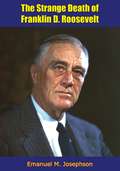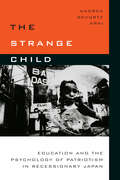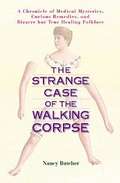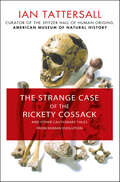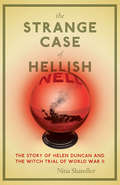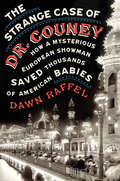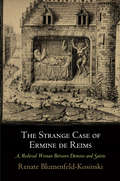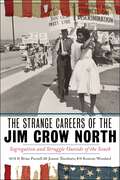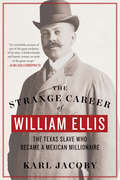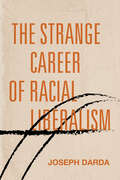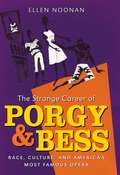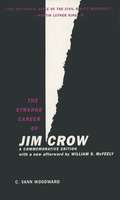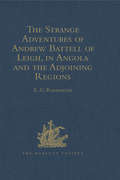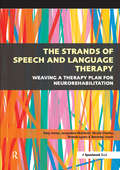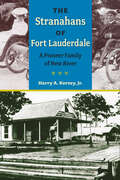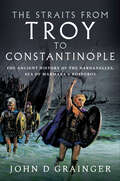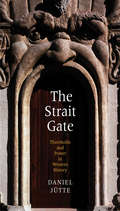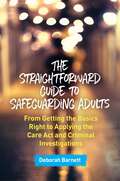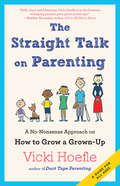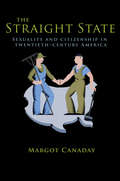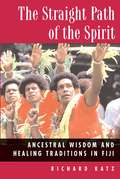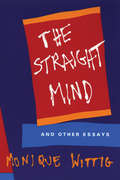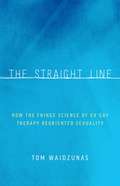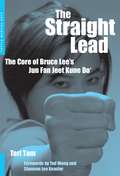- Table View
- List View
The Strange Death of Franklin D. Roosevelt: History of the Roosevelt-Delano Dynasty, America’s Royal Family [Revised Edition]
by Emanuel M. JosephsonIn The Strange Death of Franklin D. Roosevelt, which was first published in this revised edition in 1959, American medical researcher Emanuel M. Josephson addresses his controversial conspiracy theory surrounding the basis of the power of the Roosevelt-Delano Dynasty.
The Strange Child: Education and the Psychology of Patriotism in Recessionary Japan
by Andrea Gevurtz AraiThe Strange Child examines how the Japanese financial crisis of the 1990s gave rise to "the child problem," a powerful discourse of social anxiety that refocused concerns about precarious economic futures and shifting ideologies of national identity onto the young. Andrea Arai's ethnography details the different forms of social and cultural dislocation that erupted in Japan starting in the late 1990s. Arai reveals the effects of shifting educational practices; increased privatization of social services; recessionary vocabulary of self-development and independence; and the neoliberalization of patriotism. Arai argues that the child problem and the social unease out of which it emerged provided a rationale for reimagining governance in education, liberalizing the job market, and a new role for psychology in the overturning of national-cultural ideologies. The Strange Child uncovers the state of nationalism in contemporary Japan, the politics of distraction around the child, and the altered life conditions of--and alternatives created by--the recessionary generation.
The Strange Case of the Walking Corpse: A Chronicle of Medical Mysteries, Curious Remedies, and Bizarre but True Healing Folklore
by Nancy ButcherDid you know that bananas can cure warts; chewing on raw ginger can relieve nausea; sniffing vanilla can help suppress your appetite; or that raw potato can soothe a burn? Healing is full of curious remedies-some based on time-honored folklore, others straight from the medical journals. Nancy Butcher has gathered together some of the most unusual natural cures that have been proven effective today, and even throws in some unbelievable and-thankfully-abandoned therapies from times past. Filled with case histories of unique illnesses, historic documentation of strange medical practices, and the author's own insightful commentary, this book explains not only how to cure headaches, sleep better, and improve your sex life, but also that people with Cotard's syndrome actually believe they are dead.
The Strange Case of the Rickety Cossack: And Other Cautionary Tales from Human Evolution
by Ian TattersallIn his new book The Strange Case of the Rickety Cossack, human paleoanthropologist Ian Tattersall argues that a long tradition of "human exceptionalism" in paleoanthropology has distorted the picture of human evolution. Drawing partly on his own career—from young scientist in awe of his elders to crotchety elder statesman—Tattersall offers an idiosyncratic look at the competitive world of paleoanthropology, beginning with Charles Darwin 150 years ago, and continuing through the Leakey dynasty in Africa, and concluding with the latest astonishing findings in the Caucasus.The book's title refers to the 1856 discovery of a clearly very old skull cap in Germany's Neander Valley. The possessor had a brain as large as a modern human, but a heavy low braincase with a prominent brow ridge. Scientists tried hard to explain away the inconvenient possibility that this was not actually our direct relative. One extreme interpretation suggested that the preserved leg bones were curved by both rickets, and by a life on horseback. The pain of the unfortunate individual's affliction had caused him to chronically furrow his brow in agony, leading to the excessive development of bone above the eye sockets. The subsequent history of human evolutionary studies is full of similarly fanciful interpretations. With tact and humor, Tattersall concludes that we are not the perfected products of natural processes, but instead the result of substantial doses of random happenstance.
The Strange Case of Hellish Nell: The Story of Helen Duncan and the Witch Trial of World War II
by Nina ShandlerOn March 23, 1944, as the allied forces prepared for D-Day, Britain’s most famous psychic, Helen Duncan-"Nell” to her family-stood in the dock of Britain’s highest criminal court accused of. . . witchcraft. It was a trial so bizarre Winston Churchill grumbled, "Why all this tomfoolery?” But the Prime Minister was not privy to the Military Intelligence agenda fueling the prosecution: Duncan’s séances were accurately revealing top-secret British ship movements. The authorities wanted "Hellish Nell” silenced. Using diaries, personal papers, interviews, and declassified documents, Nina Shandler resurrects this strange courtroom episode and the shadowy world of wartime secrets and psychics. Sometimes comic, sometimes tragic, The Strange Case of Hellish Nell is a true crime tale laced with supernatural phenomena and wartime intrigue.
The Strange Case of Dr. Jekyll and Mr. Hyde class 9 - West Bengal Board
by Robert Louis StevensonAn accessible version of this book has been created, courtesy mjunction services limited. The Expert Committee has selected The Strange Case of Dr. Jekyll and Mr. Hyde by Robert Louis Stevenson, to be the Rapid Reader for class IX English First Language learners. While offering a powerful insight into the antithetical nature of human beings, the novel also provides an exciting read for the students.
The Strange Case of Dr. Couney: How a Mysterious European Showman Saved Thousands of American Babies
by Dawn RaffelThe extraordinary tale of how a mysterious immigrant "doctor" became the revolutionary innovator of saving premature babies--by placing them in incubators in World's Fair side shows and on Coney Island and Atlantic City. What kind of doctor puts his patients on display?As Dawn Raffel artfully recounts, Dr. Couney figured out he could use incubators and careful nursing to keep previously doomed infants alive, and at the same time make good money displaying these babies alongside sword swallowers, bearded ladies, and burlesque shows. How this turn-of-the-twentieth-century émigré became the savior to families with premature infants, known then as "weaklings"--while ignoring the scorn of the medical establishment and fighting the climate of eugenics--is one of the most astounding stories of modern medicine. And as readers will find, Dr. Couney, for all his opportunistic entrepreneurial gusto, is a surprisingly appealing character, someone who genuinely cared for the well-being of his tiny patients. But he had something to hide.Drawing on historical documents, original reportage, and interviews with surviving patients, acclaimed journalist and magazine editor Dawn Raffel tells the marvelously eccentric story of Couney's mysterious carnival career, his larger-than-life personality, and his unprecedented success as the savior of tiny babies.
The Strange Case of Ermine de Reims
by Renate Blumenfeld-KosinskiIn 1384, a poor and illiterate peasant woman named Ermine moved to the city of Reims with her elderly husband. Her era was troubled by war, plague, and schism within the Catholic Church, and Ermine could easily have slipped unobserved through the cracks of history. After the loss of her husband, however, things took a remarkable but frightening turn. For the last ten months of her life, Ermine was tormented by nightly visions of angels and demons. In her nocturnal terrors, she was attacked by animals, beaten and kidnapped by devils in disguise, and exposed to carnal spectacles; on other nights, she was blessed by saints, even visited by the Virgin Mary. She confessed these strange occurrences to an Augustinian friar known as Jean le Graveur, who recorded them all in vivid detail. Was Ermine a saint in the making, an impostor, an incipient witch, or a madwoman? Renate Blumenfeld-Kosinski ponders answers to these questions in the historical and theological context of this troubled woman's experiences. With empathy and acuity, Blumenfeld-Kosinski examines Ermine's life in fourteenth-century Reims, her relationship with her confessor, her ascetic and devotional practices, and her reported encounters with heavenly and hellish beings. Supplemented by translated excerpts from Jean's account, The Strange Case of Ermine de Reims brings to life an episode that helped precipitate one of the major clerical controversies of late medieval Europe, revealing surprising truths about the era's conceptions of piety and possession.
The Strange Careers of the Jim Crow North: Segregation and Struggle outside of the South
by Jeanne Theoharis Brian PurnellDid American racism originate in the liberal North? An inquiry into the system of institutionalized racism created by Northern Jim Crow Jim Crow was not a regional sickness, it was a national cancer. Even at the high point of twentieth century liberalism in the North, Jim Crow racism hid in plain sight. Perpetuated by colorblind arguments about “cultures of poverty,” policies focused more on black criminality than black equality. Procedures that diverted resources in education, housing, and jobs away from poor black people turned ghettos and prisons into social pandemics. Americans in the North made this history. They tried to unmake it, too. Liberalism, rather than lighting the way to vanquish the darkness of the Jim Crow North gave racism new and complex places to hide. The twelve original essays in this anthology unveil Jim Crow’s many strange careers in the North. They accomplish two goals: first, they show how the Jim Crow North worked as a system to maintain social, economic, and political inequality in the nation’s most liberal places; and second, they chronicle how activists worked to undo the legal, economic, and social inequities born of Northern Jim Crow policies, practices, and ideas. The book ultimately dispels the myth that the South was the birthplace of American racism, and presents a compelling argument that American racism actually originated in the North.
The Strange Career of William Ellis: The Texas Slave Who Became A Mexican Millionaire
by Karl JacobyA prize-winning historian tells a new story of the black experience in America through the life of a mysterious entrepreneur. To his contemporaries in Gilded Age Manhattan, Guillermo Eliseo was a fantastically wealthy Mexican, the proud owner of a luxury apartment overlooking Central Park, a busy Wall Street office, and scores of mines and haciendas in Mexico. But for all his obvious riches and his elegant appearance, Eliseo was also the possessor of a devastating secret: he was not, in fact, from Mexico at all. Rather, he had begun life as a slave named William Ellis, born on a cotton plantation in southern Texas during the waning years of King Cotton. After emancipation, Ellis, capitalizing on the Spanish he learned during his childhood along the Mexican border and his ambivalent appearance, engaged in a virtuoso act of reinvention. He crafted an alter ego, the Mexican Guillermo Eliseo, who was able to access many of the privileges denied to African Americans at the time: traveling in first-class train berths, staying in upscale hotels, and eating in the finest restaurants. Eliseo's success in crossing the color line, however, brought heightened scrutiny in its wake as he became the intimate of political and business leaders on both sides of the US-Mexico border. Ellis, unlike many passers, maintained a connection to his family and to black politics that also raised awkward questions about his racial status. Yet such was Ellis's skill in manipulating his era's racial codes, most of the whites he encountered continued to insist that he must be Hispanic even as Ellis became embroiled in scandals that hinted the man known as Guillermo Eliseo was not quite who he claimed to be. The Strange Career of William Ellis reads like a novel but offers fresh insights on the history of the Reconstruction era, the US-Mexico border, and the abiding riddle of race. At a moment when the United States is deepening its connections with Latin America and recognizing that race is more than simply black or white, Ellis's story could not be more timely or important.
The Strange Career of Racial Liberalism (Post*45)
by Joseph DardaHow Americans learned to wait on time for racial change What if, Joseph Darda asks, our desire to solve racism—with science, civil rights, antiracist literature, integration, and color blindness—has entrenched it further? In The Strange Career of Racial Liberalism, he traces the rise of liberal antiracism, showing how reformers' faith in time, in the moral arc of the universe, has undercut future movements with the insistence that racism constitutes a time-limited crisis to be solved with time-limited remedies. Most historians attribute the shortcomings of the civil rights era to a conservative backlash or to the fracturing of the liberal establishment in the late 1960s, but the civil rights movement also faced resistance from a liberal "frontlash," from antiredistributive allies who, before it ever took off, constrained what the movement could demand and how it could demand it. Telling the stories of Ruth Benedict, Kenneth Clark, W. E. B. Du Bois, John Howard Griffin, Pauli Murray, Lillian Smith, Richard Wright, and others, Darda reveals how Americans learned to wait on time for racial change and the enduring harm of that trust in the clock.
The Strange Career of Porgy and Bess
by Ellen NoonanCreated by George Gershwin and DuBose Heyward and sung by generations of black performers, Porgy and Bess has been both embraced and reviled since its debut in 1935. In this comprehensive account, Ellen Noonan examines the opera's long history of invention and reinvention as a barometer of twentieth-century American expectations about race, culture, and the struggle for equality. In its surprising endurance lies a myriad of local, national, and international stories.For black performers and commentators, Porgy and Bess was a nexus for debates about cultural representation and racial uplift. White producers, critics, and even audiences spun revealing racial narratives around the show, initially in an attempt to demonstrate its authenticity and later to keep it from becoming discredited or irrelevant. Expertly weaving together the wide-ranging debates over the original novel, Porgy, and its adaptations on stage and film with a history of its intimate ties to Charleston, The Strange Career of "Porgy and Bess" uncovers the complexities behind one of our nation's most long-lived cultural touchstones.
The Strange Career of Jim Crow
by C. Vann Woodward William S. McFeely (afterword]C. Vann Woodward, who died in 1999 at the age of 91, was America's most eminent Southern historian, the winner of a Pulitzer Prize for Mary Chestnut's Civil War and a Bancroft Prize for The Origins of the New South. Now, to honor his long and truly distinguished career, Oxford is pleased to publish this special commemorative edition of Woodward's most influential work, The Strange Career of Jim Crow. The Strange Career of Jim Crow is one of the great works of Southern history. Indeed, the book actually helped shape that history. Published in 1955, a year after the Supreme Court in Brown v. Board of Education ordered schools desegregated, Strange Career was cited so often to counter arguments for segregation that Martin Luther King, Jr. called it "the historical Bible of the civil rights movement. " The book offers a clear and illuminating analysis of the history of Jim Crow laws, presenting evidence that segregation in the South dated only to the 1890s. Woodward convincingly shows that, even under slavery, the two races had not been divided as they were under the Jim Crow laws of the 1890s. In fact, during Reconstruction, there was considerable economic and political mixing of the races. The segregating of the races was a relative newcomer to the region. Hailed as one of the top 100 nonfiction works of the twentieth century, The Strange Career of Jim Crow has sold almost a million copies and remains, in the words of David Herbert Donald, "a landmark in the history of American race relations. "
The Strange Adventures of Andrew Battell of Leigh, in Angola and the Adjoining Regions: Reprinted from 'Purchas his Pilgrimes' (Hakluyt Society, Second Series)
by E. G. RavensteinAdventures between 1589 and 1607, edited, with notes and a concise history of Kongo and Angola. With part of Anthony Knivet's account of his activities in the same countries, from the same source. This is a new print-on-demand hardback edition of the volume first published in 1901.
The Strands of Speech and Language Therapy: Weaving Plan for Neurorehabilitation
by Katy JamesThis book is written by a team of speech and language therapists from The Wolfson Neurorehabilitation Centre. It is intended for practitioners working with patients who have acquired communication disorders resulting from brain injury: aphasia, cognitive-communication disorder, dysarthria, apraxia. The authors believe that a therapeutic programme should have it's foundations in the linguistic, non-verbal, neurological and neurospsychological perspective of the patient's difficulties. The approach the team has developed consists of several different strangs of therapy, with each strand representing an element of the rehabilitation process: assessment; goal planning; specific individualised treatment; education; friends and family; and psychosocial adjustment. This book describes these strands, illustrates in a user-friendly way how each one relates to therapy, and fives some practical ideas of how practitioners might work within them. Each chapter begins with the guiding principles and evidence bases that underlie the rationale for one particular strand of therapy. They then follow examples of practice and case studies of a real-life example of each strand. This book describes a speech and language therapy service that aims to be responsive to patients' needs and develops tailor-made intervention programmes that arer unique to each individual. It includes CD containing assessments and practical tools.
The Stranahans of Fort Lauderdale: A Pioneer Family of New River (Florida History and Culture)
by Harry A. Kersey Jr.Two individuals who shaped the development of one of Florida's major urban centers When they married in 1900, Frank and Ivy Stranahan began a life together on the Florida frontier that would shape and define the development of one of the state's most sophisticated urban centers. Pioneering spirit and economic enterprise linked them to Seminole Indians, venture capitalists, and colorful entrepreneurs along the New River settlement; today they're recognized as a founding family of Fort Lauderdale and their riverfront home has been restored and designated a National Historic Landmark. Frank Stranahan came south from Ohio in 1893 to run an overnight camp on the stagecoach line carrying passengers from Lake Worth to the Miami area. He soon opened a trading post that thrived on commerce in pelts, plumes, and hides with Seminole Indians, who in turn purchased goods and groceries to take back to their camps in the Everglades. Stranahan's business interests expanded to include real estate and banking. An honest businessman, he became a respected political and civic leader, instrumental in the birth of Fort Lauderdale in 1911. When the Florida land boom collapsed and his bank closed, Stranahan's mental and physical health failed, and he committed suicide in 1929. Ivy Cromartie, a native Floridian, was 18 when she arrived at the settlement as its first schoolteacher and met her future husband. Energetic and articulate, she focused her activities outside the home. Besides teaching, she was active in a variety of reform movements ranging from Audubon Society efforts to save the plume birds to temperance and women's suffrage, working mainly through the Florida Federation of Women's Clubs. She is best remembered for her role as an advocate for Indigenous American rights—especially education and child welfare—primarily with the Friends of the Seminoles, an organization she established in the 1930s. Before her death in 1971 she spoke frequently about her full life to reporters and historians and was interviewed extensively by Kersey.
The Straits from Troy to Constantinople: The Ancient History of the Dardanelles, Sea of Marmara & Bosporos
by John D. GraingerIn ancient times, the series of waterways now known as the Turkish Straits, comprising the Dardanelles (or Hellespont), Sea of Marmara and the Bosporus, formed both a divide and a bridge between Europe and Asia. Its western and eastern entrances were guarded, at different times, by two of the most fabled cities of all time: respectively Troy (in Asia) and Byzantion (or Byzantium, on the European coast). The narrow crossing points at the Hellespont and Bosporus were strategically important invasion routes while the waters themselves were vital routes of travel and commerce, particularly the supply of grain from the hinterland of the Black Sea to the Greek cities. This made them sought after prizes and sources of friction between successive empires, Persians, Macedonians and Romans among them, and ensured they were associated with some of the great names of history, from Odysseus to Xerxes, Alexander to Constantine the Great. John D Grainger relates the fascinating history of this pivotal region from the Trojan War to Byzantion’s refounding as the new capital of the Roman Empire. Renamed Constantinople it dominated the straits for a thousand years.
The Strait Gate
by Daniel JütteExploring a chapter not yet probed in the cultural history of the West, The Strait Gate demonstrates how doors, gates, and related technologies such as the key and the lock have shaped the way we perceive and navigate the domestic and urban spaces that surround us in our everyday lives. Jütte reveals how doors have served as sites of power, exclusion, and inclusion--and, by extension, as metaphors for salvation--in the course of Western history. This book makes it clear that doors, more than any other parts of the house, are the objects onto which we project our ideas of and anxieties about security, privacy, and shelter. Without doors, of course, houses could not exist. But even though we each walk through doorways well over a hundred times a day, we typically pay little attention to the doors we encounter. We regard them simply as a means of entering or leaving a building or room. Yet when our doors stop working as they should--when we find that we cannot lock or open them, for instance--we react with discomfort and anxiety. Drawing on a wide range of archival, literary, and visual sources, as well as on research literature across various disciplines and languages, Jütte pays particular attention to the history of the practices that have developed over the centuries in order to handle and control doors in everyday life.
The Straightforward Guide to Safeguarding Adults: From Getting the Basics Right to Applying the Care Act and Criminal Investigations
by Deborah BarnettThis new manual provides a clear, comprehensive overview of the responsibilities of professionals in relation to safeguarding adults, and how to implement these principles in frontline practice.The Care Act 2014 sets out a legal framework for how local authorities should protect adults at risk of abuse and neglect. However, the law can be complex and difficult to interpret. This straightforward manual aims to help managers, practitioners and trainers to work through the whole safeguarding process, from the very basics to the complexities of multi-agency collaboration and criminal investigation.It offers a step-by-step guide to safeguarding adults, including case studies to recognise how to put specific safeguarding principles into practice, tools for assessing risk, and tips for implementing person-centred and strength-based practice.
The Straight Talk on Parenting: A No-Nonsense Approach on How to Grow a Grown-Up
by Vicki HoefleParents these days are under a great deal of pressure to be "perfect." From psychologists to social scientists, journalists to weekend bloggers, everyone has an opinion about the do's and don'ts for raising healthy, well-adjusted--and let's not forget, polite--children in today's fast-paced world. Where does this leave parents? Too often, lacking in confidence, ill equipped, and overwhelmed. Parenting expert Vicki Hoefle makes the bold claim that it's time for parents to get off the perfection path and get back to the real job of parenting: to grow a grown-up. In this no-nonsense parenting guide, Hoefle draws upon twenty-five years of experience with helping parents see the big picture and sidestep what she calls the "detail drama" that too often trumps everyday life with our kids. Parents learn more than just strategies; they learn a methodology that allows them to help their toddlers build a strong foundation for success in adulthood.In her trademark, tell-it-like-it-is style, Hoefle tells parents to trust their intuition and develop an intentional strategy for meeting each child's unique needs. Above all, The Straight Talk on Parenting offers the confidence-boosting reminder that parenting is about practice (and a healthy dose of humor), not perfection.
The Straight State: Sexuality and Citizenship in Twentieth-Century America (Politics and Society in Modern America #64)
by Margot CanadayHow the government enforced sex and gender conformity and relegated gays to second-class citizenshipThe Straight State is the most expansive study of the federal regulation of homosexuality yet written. Unearthing startling new evidence from the National Archives, Margot Canaday shows how the state systematically came to penalize homosexuality, giving rise to a regime of second-class citizenship that sexual minorities still live under today.Canaday looks at three key arenas of government control—immigration, the military, and welfare—and demonstrates how federal enforcement of sexual norms emerged with the rise of the modern bureaucratic state. She begins at the turn of the twentieth century when the state first stumbled upon evidence of sex and gender nonconformity, revealing how homosexuality was policed indirectly through the exclusion of sexually "degenerate" immigrants and other regulatory measures aimed at combating poverty, violence, and vice. Canaday argues that the state's gradual awareness of homosexuality intensified during the later New Deal and through the postwar period as policies were enacted that explicitly used homosexuality to define who could enter the country, serve in the military, and collect state benefits. Midcentury repression was not a sudden response to newly visible gay subcultures, Canaday demonstrates, but the culmination of a much longer and slower process of state-building during which the state came to know and to care about homosexuality across many decades.Social, political, and legal history at their most compelling, The Straight State explores how regulation transformed the regulated: in drawing boundaries around national citizenship, the state helped to define the very meaning of homosexuality in America.
The Straight Path of the Spirit: Ancestral Wisdom and Healing Traditions in Fiji
by Richard KatzThe inspiring story of one man's exploration of indigenous healing in a culture fighting to preserve its spiritual health. • A firsthand account of a little-known healing tradition. • A dramatic story of self-transformation by a well-respected Harvard-educated anthropologist. In the late 1970s Richard Katz, a clinical psychologist trained in anthropology, spent two years living in a remote island community in Fiji, hoping to record the practices of its healers. At the foundation of their healing, he discovered, was the concept of the straight path, a journey through life whose truth is revealed only to the extent that it is searched for with honesty and faith. It is a way of healing that in its very essence is a way of living, a path that emphasizes the spiritual dimensions of health and the relevance of these to the community. But while interviewing healers at work, Katz was drawn into an increasingly suspenseful drama. Unexplained deaths, rumors and suspicions, and the intrusion of a zealous evangelist rocked the village and soon revealed to the author the dangerous alternative to the straight path: the misuse of power that some call witchcraft. The Straight Path of the Spirit is an engrossing story of indigenous healers and a dramatic account of cultures in collision. Through the story of his own self-transformation, Katz reveals not only those aspects of life essential for the Fijians as they struggle to hold onto their identity, but also what is of importance to all of us who seek to retain our humanity.
The Straight Mind: And Other Essays
by Monique WittigThese political, philosophical, and literary essays mark the first collection of theoretical writing from the acclaimed novelist and French feminist writer Monique Wittig.&“Among the most provocative and compelling feminist political visions since The Second Sex. These essays represent the radical extension of de Beauvoir&’s theory, its unexpected lesbian future. Wittig&’s theoretical insights are both precise and far-reaching, and her theoretical style is bold, incisive, even shattering.&”—Judith Butler, Johns Hopkins University
The Straight Line: How the Fringe Science of Ex-Gay Therapy Reoriented Sexuality
by Tom WaidzunasTo be taken seriously, therapies that claim to &“cure&” homosexuality wrap themselves in lab coats. Even though the fit is bad, and such therapies and their theorists now inhabit the scientific fringe, the science of sexuality has made some adjustments, too, Tom Waidzunas tells us in this provocative work. Intervening in the politics of sexuality and science, The Straight Line argues that scientific definitions of sexual orientation do not merely reflect the results of investigations into human nature, but rather emerge through a process of social negotiation between opposing groups. The demedicalization of homosexuality and the discrediting of reparative therapies, ex-gay ministries, and reorientation research have, Waidzunas contends, required scientists to enforce key boundaries around scientific expertise and research methods. Drawing on extensive participant observation at conferences for ex-gays, reorientation therapists, mainstream psychologists, and survivors of ex-gay therapy, as well as interviews with experts and activists, The Straight Line traces reorientation debates in the United States from the 1950s to the present, following homosexuality therapies from the mainstream to the margins. As the ex-gay movement has become increasingly transnational in recent years, Waidzunas turns to Uganda, where ideas about the scientific nature of homosexuality influenced the passage of the Anti-Homosexuality Act of 2014. While most studies treat the ex-gay movement as a religious phenomenon, this book looks at how the movement, in its attempts to establish legitimacy, has engaged with scientific institutions, shaping virulent anti-gay public policy.
The Straight Lead
by Teri Tom Ted Wong Shannon Lee KeaslerA key element in the Jeet Kune Do arsenal, the straight punch is a deceptively simple technique that Bruce Lee described as the most difficult move in Jeet Kune Do- "Only one in 10,000 can handle it."The Straight Lead describes the development of the straight punch in Western martial arts and describes Lee's refinement of the technique. It also offers a thorough instruction in the complexity and power of the move-showing martial artists of any discipline how to incorporate this devastating attack into their repertoire.
